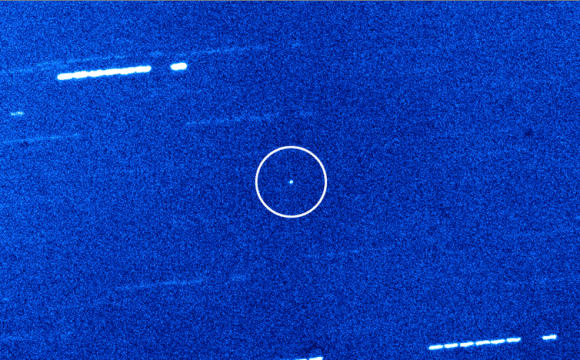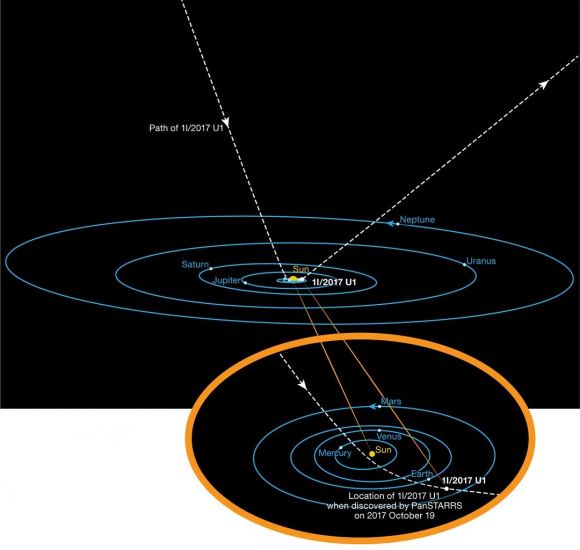On October 19th, 2017, the first interstellar object – named 1I/2017 U1 (aka. ‘Oumuamua) – to be observed in our Solar System was detected. In the months that followed, multiple follow-up observations were conducted to gather more data on its composition, shape, and possible origins. Rather than dispel the mystery surrounding the true nature of ‘Oumuamua – is a comet or an asteroid? – these efforts have only managed to deepen it.
In a recent study, Harvard Professor Abraham Loeb and Shmuel Bialy – a postdoctoral researcher from the Smithsonian Center for Astrophysics (CfA) – addressed this mystery by suggesting that ‘Oumuamua may be an extra-terrestrial solar sail. Building on this, Loeb and Amir Siraj (a Harvard undergraduate student) conducted a new study that indicated that hundreds of “‘Oumuamua-like” objects could be detectable in our Solar System.
The study which describes their findings recently appeared online and is being reviewed for publication by the Monthly Notices of the Royal Astronomical Society. The study was led by Amir Siraj, an undergraduate student with Harvard’s Astronomy Department, and Prof. Abraham Loeb – the Frank B. Baird Jr. Professor of Science at Harvard University and the Chair of the Harvard Astronomy Department.

When Oumuamua was first detected by the Panoramic Survey Telescope and Rapid Response System-1 (Pan-STARRS-1) in Hawaii, scientists were uncertain as to what it was. Initially, the object was thought to be an interstellar comet, but observations performed by the European Southern Observatory (ESO) and other astronomers indicated that it had a high density and that it was spinning rapidly (which is more consistent with an asteroid).
However, separate observations performed using the ESO’s Very Large Telescope in Chile and the William Herschel Telescope in La Palma indicated that the object’s spectra was consistent with an icy composition. And while ‘Oumuamua did not form a gaseous envelop or tail while making its closest pass to the Sun, it did accelerate out of our Solar System like a comet.
Based on observations performed with the Hubble Space Telescope, an international team of astronomers concluded that ‘Oumuamua’s increase in velocity was probably due to solar heating, which would cause any frozen volatiles it carried (i.e. water, carbon dioxide, ammonia, methane, etc.) to sublimate and vent from its surface (aka. outgassing).
But as yet another research team pointed out, if outgassing were indeed responsible for the acceleration, it would have also caused a rapid evolution in ‘Oumuamua’s spin (which was not observed). To this, Loeb and Shmuel Bialy (in a study that was released in October 2018) that offered the rather intriguing counter-explanation.
As Professor Loeb explained to Universe Today via email:
“Our first interstellar guest appeared to be weird and unlike anything we have seen before. By the time we realized it, the guest was already out the door with its image fading into the dark street, so we did not have a chance to get a second look at its mysterious qualities. We have limited data, most recently the lack of detection by the Spitzer Space Telescope, which implies that `Oumumua is small and at least ten times more shiny than the typical asteroids in the Solar System.
“We do not have a photo of `Oumuamua but its brightness owing to reflected sunlight varied by a factor of 10 as it rotated periodically every eight hours. This implies that `Oumuamua has an extreme shape with its length at least 5-10 times larger than its projected width. Moreover, an analysis of its tumbling motion concluded that it would be at its highest excitation state as expected from its tumultuous journey, if it has a pancake-like geometry. The inferred shape is more extreme than for all asteroid previously seen in the Solar System, which have an axes ratio of at most 3.”
Basically, Bialy and Loeb considered the possibility that ‘Oumuamua could in fact be a light sail, a form of spacecraft that relies on radiation pressure to generate propulsion – similar to what Breakthrough Starshot (the Advisory Committee of which Prof. Loeb is the Chair of) is currently developing. They also calculated its likely shape, thickness, mass-to-area ratio, and whether such an object would be able to survive an interstellar journey.
Ultimately, there study indicated that such a spacecraft would be technically feasible, but that far too many unknowns exist about ‘Oumuamua to say definitely that it was a spacecraft. In the end, they concluded that ‘Oumuamua, whether it was naturally-occurring or not, represents an entirely new class of interstellar object, and that we should be on the lookout for more such objects in the future.

This recommendation is based in part on previous research that has indicated that our Solar System has likely captured thousands of such interstellar objects over the course of its history. This was followed not long after by astronomers locating an interstellar object near Jupiter that appeared to be in a retrograde orbit around the Sun – an indication that it came from another star system and had been captured by our own.
Building on all this, Siraj and Loeb decided to explore the orbital properties of captured interstellar objects in the Solar System to see how many objects similar to ‘Oumuamua could be found. For the sake of their study, they conducted dynamical simulations of the Jupiter-Sun system and random initial conditions to determine the orbits that such objects would have.
They then compared the results of these simulations to data obtained by the Panoramic Survey Telescope and Rapid Response System (Pan STARRS) survey. As Loeb indicated:
“This yields roughly one such object (of a hundred meter size) per the volume defined by the Earth’s motion around the Sun. In total, each planetary system needs to eject about 10^{15} such objects during its lifetime… Out of those a small fraction is trapped by the Solar System, as objects pass close to Jupiter and lose energy through their gravitational interaction with it. The Sun-Jupiter system acts as a fishing net that hosts a few thousand captured objects at any time. The objects eventually get kicked out of the system, but new ones get captured, and so there is a steady population.

In short, they found that thousands of ‘Oumuamua-like objects are likely to exist today in our Solar System, and that hundreds could be identified based on their orbits. They also calculated that the Large Synoptic Survey Telescope (LSST), which is currently under construction and is expected to be fully operational by January of 2022, will be able to discover tens of these trapped objects.
Siraj and Loeb also identified four specific candidates for trapped objects in their study that might have been already discovered by past surveys. These objects are designated as 2011 SP25, 2017 RR2, 2017 SV13, and 2018 TL6, which range from 8.26 to 23.65 AU for the Sun and orbit it with a period of 23.76 to 115 years.
“Since these objects are trapped, we can fly by them, take a photograph or land on their surface,” Loeb added. “This will allow us to learn about their structure, composition and origins. It will also allow us to infer better the conditions at their nurseries outside the Solar System. And finally, it may allow us to identify objects of artificial origin, like finding plastic bottles on an otherwise pristine beach.”
The implications of these studies would be immense. Assuming that such objects are naturally-occurring, the study of them will reveal things about the conditions of other planetary systems, which could save us the need to send interstellar probes to investigate them directly. But as Loeb pointed out, if they are in fact artificial objects – such as the wrecks of alien probes (as they suggested with ‘Oumuamua) – the implications would be far greater:
“This will be revolutionary, as it will demonstrate that we are not alone and will shed light on advanced technologies beyond our own. It holds the potential for being the most important result in science and technology for centuries to come.”

The arrival and departure of ‘Oumuamua, an interstellar object that has defied classification, has understandably been a source of excitement for scientists. But to know that many objects like it exists in our Solar System already, and knowing where we could find some to study, is even more exciting. But the fact that we will be able to do so in just a few years time? Very exciting!
And while these objects may turn out to NOT be the long-awaited resolution to the Fermi Paradox, the fact that they could give us an inside look at other star systems in our galaxy will be of immense scientific value.
To hear Professor Loeb speak about all the scientific finds related to ‘Oumuamua’s and what they could mean, check out this podcast (“Our Interstellar Visitor“) on After-On, hosted by novelist Rob Reid.

